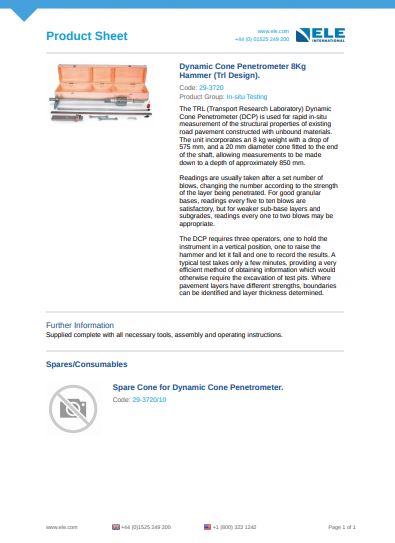Dynamic Cone Penetrometer 8Kg Hammer (Trl Design)
- The TRL (Transport Research Laboratory) Dynamic Cone Penetrometer (DCP) is used for rapid in-situ measurement of the structural properties of existing road pavement constructed with unbound materials.
- The unit incorporates an 8 kg weight with a drop of 575 mm, and a 20 mm diameter cone fitted to the end of the shaft, allowing measurements to be made down to a depth of approximately 850 mm.
Description
The TRL (Transport Research Laboratory) Dynamic Cone Penetrometer (DCP) is used for rapid in-situ measurement of the structural properties of existing road pavement constructed with unbound materials. The unit incorporates an 8 kg weight with a drop of 575 mm, and a 20 mm diameter cone fitted to the end of the shaft, allowing measurements to be made down to a depth of approximately 850 mm.
Readings are usually taken after a set number of blows, changing the number according to the strength of the layer being penetrated. For good granular bases, readings every five to ten blows are satisfactory, but for weaker sub-base layers and subgrades, readings every one to two blows may be appropriate.
The DCP requires three operators, one to hold the instrument in a vertical position, one to raise the hammer and let it fall and one to record the results. A typical test takes only a few minutes, providing a very efficient method of obtaining information which would otherwise require the excavation of test pits. Where pavement layers have different strengths, boundaries can be identified and layer thickness determined.
Physical & Performance
| Description | Dynamic Cone Penetrometer |
| Weight, kg | 20 |
For detailed specifications refer to the Product Brochure.

ELE
Dynamic Cone Penetrometer 8Kg Hammer (Trl Design)
The DCP requires three operators, one to hold the instrument in a vertical position, one to raise the hammer and let it fall and one to record the results. A typical test takes only a few minutes, providing a very efficient method of obtaining information which would otherwise require the excavation of test pits. Where pavement layers have different strengths, boundaries can be identified and layer thickness determined.






 Shop
Shop